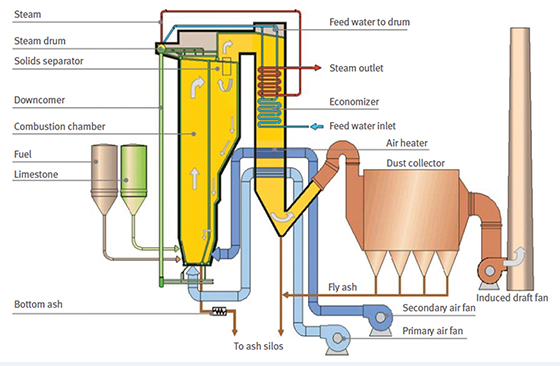CFB Boiler Technology and Process
Circulating fluidized bed (CFB) technology is taking a growing share of the international coal-fired power generation market, particularly in the Pacific Rim and China. Indigenous designs are also growing in popularity.
The fluidized bed combustion (FBC) system is favored among developers and owners of power plants for its ability to consume lower-cost, opportunity fuels in an environmentally acceptable manner. There are literally hundreds of power systems around the world relying on the technology, and its share of the coal-fired market has been steadily increasing. The dominant FBC technology for solid fuel–fired power generation is the circulating fluidized bed (CFB).

The CFB is particularly adept at burning low-grade, high-ash coals and cofiring with other low-grade waste materials. Depending upon the emissions limits imposed on the plant, direct injection of limestone into the bed is often sufficient to meet SO2 removal requirements, without the additional desulfurization equipment found on modern pulverized coal power plants. However, the current trend in the more economically developed world is for environmental authorities to also require selective noncatalytic reduction and dry flue gas desulfurization systems to further reduce NOx and SO2, respectively.
Unique Combustion Process
CFB are often designed for multiple fuels in order to leverage global pricing of alternative, lower-quality solid fuels. It stands to reason that when multiple fuels are specified, design compromises are required.
For example, designing a CFB requires a thorough understanding of the various fuel-specific operating parameters, such as gas velocity, gas/solids residence times, solids circulation rates, and bed temperature for the proposed fuels, as well as the sorbent properties. The furnace geometry, particularly its height, affects the mixing of the fuel, air, bed material, and sorbent, and therefore greatly determines furnace residence time. Inside the furnace, a denser bed near the bottom forms during operation, decreasing in density with increasing furnace height. Furnace heat transfer, and therefore combustion efficiency, is proportional to the solids density in the furnace. In sum, the CFB designer must balance the additional cost of furnace surface with the desire for high combustion efficiency for each fuel.
If you want to know more information about CFB boiler technology and process, CFB boiler cost or CFB boiler price, please feel free to consult our online customer service or Email zbgboiler@zzboiler.com.